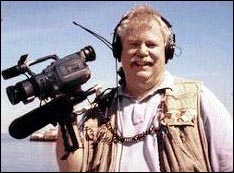Videomith
by
Steven Trent Smith
Taking the HDTV Plunge
|

|
After writing two
columns about High Definition Television (HDTV), I decided to take the
plunge. Videosmith just took delivery of some Sony 1080i HD gear. Because
of the raging buzz about 24p sweeping the production industry, we were
able to take advantage of some super savings on a 1080i deck and camcorder.
Okay, so we can't shoot native "film-look," but we can shoot wonderfully
brilliant, awesomely clear video. And we're going to charge "Betacam"
prices for it. To rent an HD camera for a day costs about $1200. We're
going to do it for $695, because of those big discounts Sony was offering.
We're telling our clients that they can shoot HD for Beta prices, and,
even if they don't need high def images today, they'll have their HD
masters sitting on the shelf for the day when they do need the better
quality. We call it "future proofing."
In the past, editing HDTV has been very expensive. But now you can put
together a G4 with Final Cut Pro, an HD capture board and a terabyte
of hard disk space (yeah, a thousand gigabytes), for about $50,000.
And with that, you can edit uncompressed HD video. That's pretty amazing,
because as recently as six months ago, the hardware/software would have
cost five to ten times that! We live in interesting times.
Which brings me to the small format news for this issue.
JVC brought around their new three-chip miniDV camcorder the other dayą
the GV-DV300U. It looks a bit like a lumpy, overgrown Sony PD-150. It's
got the usual specs we've come to expect from these little camcordersą
1/3" inch chips, LCD screen, color viewfinder, manual controls,
XLR connectors. It also has an astonishing 700 lines of resolution,
12-bit processing and is switchable between 16:9 and 4:3. But the JVC
does a really cool thing. When you snap a purple adapter to the bottom
of the camera, you can stream MPEG-4 video live over the Internet. The
quality is fair, and there is about a fifteen second delay between taking
and displaying.
But this opens up all sorts of interesting possibilities for Digital
Journalists (though JVC is seriously eying the wedding photographer
market, thinking there must be a need for streaming live weddings to
those guests unable to attend). The DV300 "Streamcorder" is in
stores now, for less than $4000. The KA-DV300U streamer will be available
soon, for less than $1500.
Panasonic also has something new and interesting. To take advantage
of all the interest among independent filmmakers in 24p, they are introducing
a miniDV camera that will record in 60i and 24p. The 24p mode means
the tape can be transferred frame-for-frame to motion picture film.
The AG-DVX-100 will be shown first at the NAB show in Las Vegas early
in April. Watch for a 24p response from arch-rival Sony. Dunno what
Canon might do.
Among the indy community, DV has really taken off. Canon got on the
bandwagon a couple of years ago by selling PAL XL-1s in the United States.
This appealed to the filmmakers, because PAL shoots at 25 frames. Director
Steven Soderburgh ("Traffic"), shot some eighty-five percent of
his latest feature, "Full Frontal," with a pair of PAL XL-1's.
The latest issue of the "American Cinematographer" has a long piece
about tricking out the XL-1 for feature filmmaking. They show it with
a full-size matte-box, follow-focus, and a $7500 adapter that lets you
put expensive Zeiss primes lenses on the little camcorder. Some might
call this overkill. But if miniDV is taking over the world, then more
power to it.
© 2002 Steven Trent Smith
http://www.videosmith.com
|
